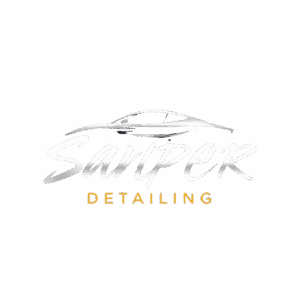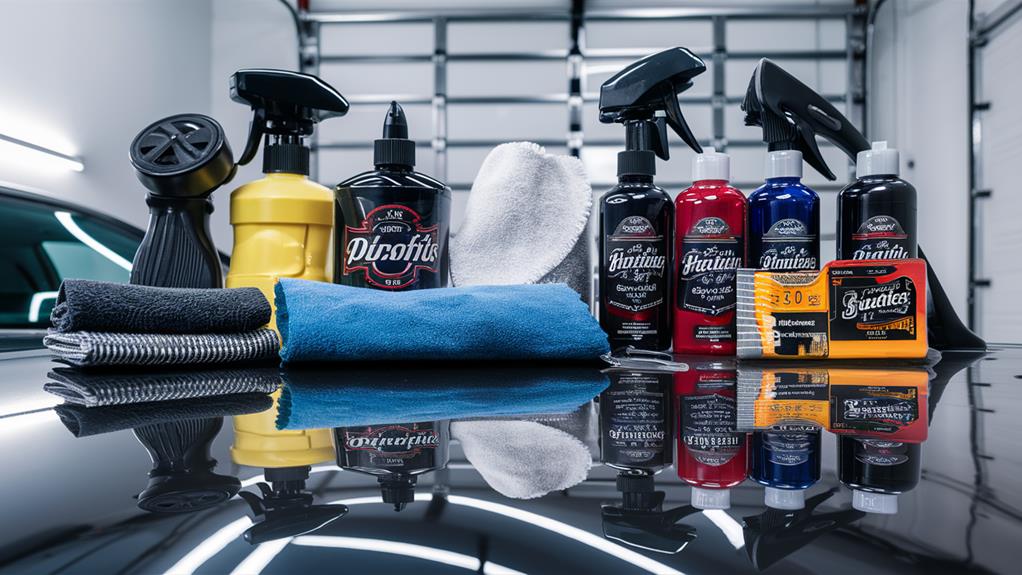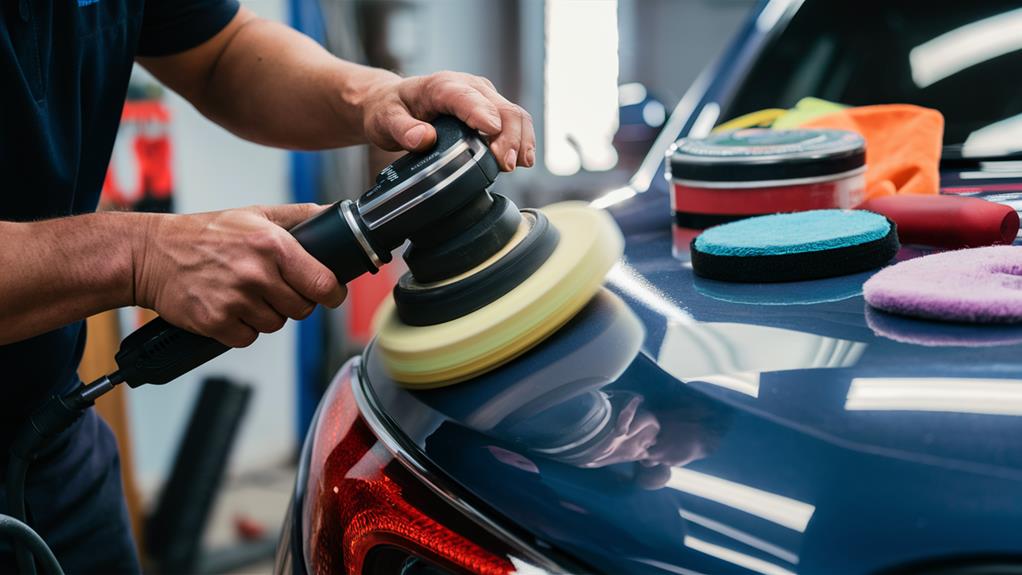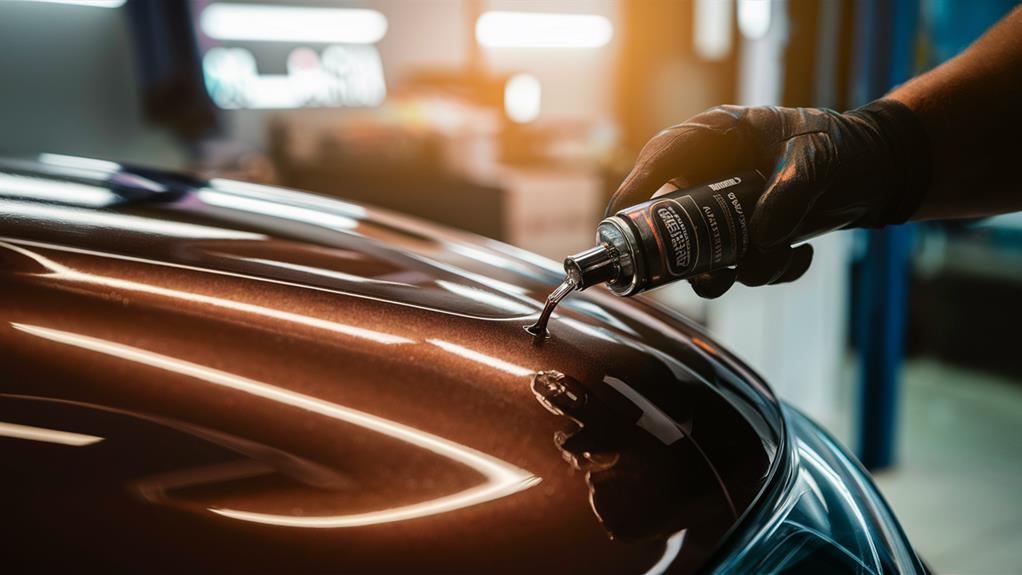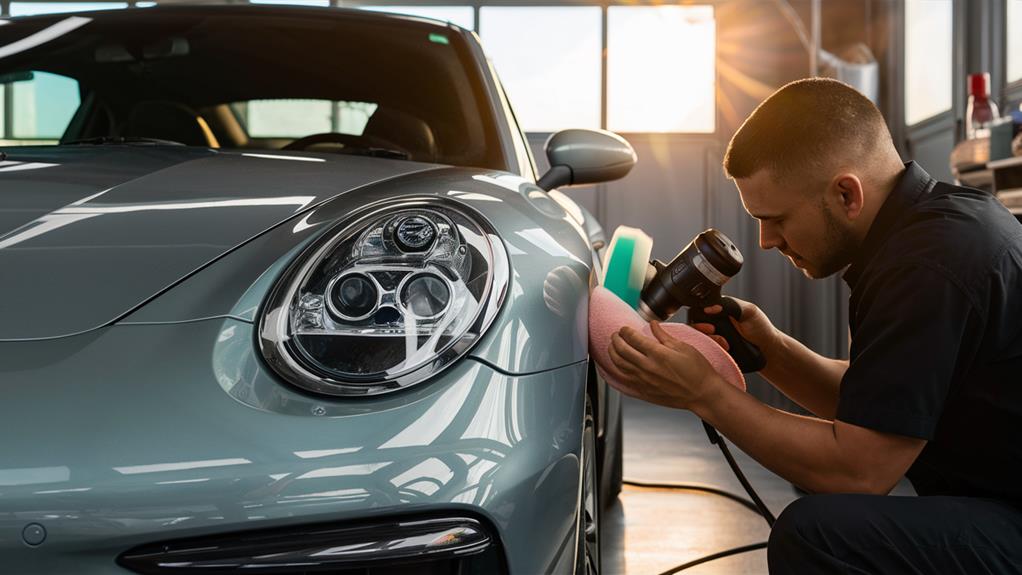The complete paint correction process involves a step-by-step approach to restore a vehicle’s shine by removing imperfections like scratches and oxidation. Technicians first assess the vehicle’s condition using various lighting techniques and specialized tools, such as polishers and compounds. They meticulously wash and decontaminate the surface before polishing, applying techniques specific to the paint type. After addressing defects, protective solutions, like ceramic coatings or sealants, are applied to maintain the new shine. This comprehensive method significantly enhances appearance and market value, ensuring the vehicle looks its best. Further insights reveal additional strategies for optimal results.
Key Takeaways
- Paint correction involves removing defects like scratches and oxidation to enhance the vehicle’s original shine and clarity.
- Proper evaluation and inspection identify paint damage, influencing the selection of correction techniques and tools used.
- Specialized tools like polishing machines and compounds are essential for effective paint restoration, impacting the overall outcome.
- The polishing process restores clarity and depth, while minimizing further damage risk prepares the paint for protective treatments.
- Applying protective solutions like sealants or ceramic coatings maintains the vehicle’s aesthetic appeal and longevity, safeguarding against environmental damage.
Understanding Paint Correction
Paint correction is frequently misunderstood, yet it plays a crucial role in automotive detailing. This process involves the meticulous removal of paint defects, such as scratches, swirl marks, and oxidation, which can significantly hinder the vehicle’s overall appearance. By utilizing specialized tools and compounds, detailers can enhance the paint’s surface clarity, restoring the car’s original luster.
During paint correction, technicians assess the vehicle’s paintwork to identify specific defects. They then select appropriate techniques, such as machine polishing, to carefully abrade the clear coat layer, eliminating imperfections while preserving the paint beneath. The goal isn’t just to remove defects but to achieve a smooth, reflective surface that enhances the vehicle’s aesthetic appeal.
It’s important to note that not all vehicles require the same level of correction. Factors such as paint type, color, and the extent of damage influence the approach taken. Ultimately, a successful paint correction process leads to improved surface clarity, providing a deep, glossy finish that catches the eye. This transformation not only elevates the car’s appearance but also contributes to its long-term preservation, making paint correction a vital aspect of automotive care.
Assessing Your Vehicle’s Condition
A thorough assessment of a vehicle’s condition is essential before initiating any paint correction process. This initial evaluation allows professionals to identify specific areas of paint damage, such as scratches, swirl marks, and oxidation. By understanding the extent and type of damage, they can determine the most effective correction techniques to restore the car’s finish.
During the assessment, experts examine the paint surface using various lighting conditions. This helps reveal imperfections that may not be visible under standard lighting. They also inspect the vehicle for signs of previous repairs, such as repainting or touch-ups, which can affect the choice of correction techniques.
Additionally, professionals may employ a paint thickness gauge to measure the paint’s depth. This ensures that they don’t exceed safe limits during the correction process. The assessment also includes evaluating the type of clear coat, as different finishes may require distinct approaches to correction.
Essential Tools and Products
To achieve optimal paint correction, specific polishing tools and high-quality products are essential. Proper equipment not only improves efficiency but also enhances the final finish of the vehicle. This section will outline the necessary tools and recommend effective products for successful paint correction.
Required Polishing Tools
Achieving a flawless finish during the paint correction process requires a selection of essential polishing tools and products. Professionals utilize specific equipment that enhances efficiency and effectiveness in restoring a vehicle’s shine. Key tools include:
- Polishing Machines: Both rotary polishers and dual action polishers are crucial. Rotary polishers provide intense cutting power, while dual action polishers offer versatility and user-friendliness, making them suitable for various surfaces.
- Polishing Pads: The choice of polishing pads is essential. Foam pads come in different densities, allowing for tailored application of polishing compounds, which help remove imperfections without damaging the paint.
- Microfiber Towels and Applicators: High-quality microfiber towels are indispensable for wiping down surfaces, while foam applicators ensure even application of paint sealants and compounds, maximizing protection and shine.
In addition to these tools, detailing brushes are vital for cleaning hard-to-reach areas. Together, these tools create a comprehensive approach to paint correction, ensuring that every detail contributes to a vehicle’s overall aesthetic and longevity. Proper selection and use of these items significantly impact the outcome of the paint correction process.
Recommended Products Overview
Selecting the right products is vital for maximizing the effectiveness of the polishing tools outlined previously. A well-chosen product can significantly enhance the paint correction process, ensuring optimal results.
When considering product recommendations, it’s essential to evaluate compounds, polishes, and sealants that align with the vehicle’s paint type and condition. For instance, medium-cut compounds are ideal for removing moderate imperfections, while finer polishes work best for achieving a high-gloss finish.
Additionally, conducting product comparisons can help detail the differences in formulation and performance among various brands. Some products may contain fillers, which temporarily mask imperfections, while others focus on deep paint correction without such additives.
It’s also important to factor in the applicators used with these products. Foam pads, microfiber cloths, and wool pads each serve specific purposes and can affect the outcome of the correction process.
Washing and Decontaminating
Washing and decontaminating a car are critical steps in the paint correction process, as they prepare the surface for optimal results. A thorough wash removes dirt and grime, while decontamination targets embedded contaminants that regular washing won’t eliminate. To ensure an effective process, detailers typically follow these key steps:
- Pre Wash Techniques: Before the main wash, pre wash techniques like foam cannons or snow foam applications help loosen dirt and debris, minimizing the risk of scratches.
- Two-Bucket Method: This method involves using one bucket for soapy water and another for rinsing the wash mitt, ensuring contaminants don’t get reintroduced onto the car’s surface.
- Clay Bar Treatment: After washing, a clay bar treatment is essential for removing bonded contaminants such as tree sap, tar, or industrial fallout. This step smooths the paint surface, enabling better adhesion for subsequent products.
The Polishing Process
Once the car’s surface is thoroughly cleaned and decontaminated, the polishing process begins to restore the paint’s clarity and depth. This stage employs various polishing techniques, each calibrated to address specific paint conditions. Technicians typically utilize dual-action polishers or rotary buffers, paired with appropriate pads and compounds, to effectively remove surface imperfections such as swirl marks, light scratches, and oxidation.
The choice of polishing technique is crucial, as it determines the level of correction achievable while minimizing the risk of further damage. For instance, a softer pad and polish may be used for delicate clear coats, while more aggressive combinations might be reserved for heavily damaged surfaces. Throughout the process, technicians monitor the paint’s condition closely, ensuring optimal results without compromising the underlying finish.
Polishing benefits extend beyond mere aesthetic enhancement; it also helps to prepare the paint for subsequent protection stages, such as waxing or sealing. By eliminating imperfections and enhancing gloss, the polishing process not only rejuvenates the vehicle’s appearance but also contributes to a longer-lasting finish, making it a critical step in the complete paint correction process.
Inspecting for Imperfections
Inspecting for imperfections is a critical step in the paint correction process, as it allows technicians to identify the specific defects that need addressing. During this inspection, they look for various imperfection types, using visual indicators to guide their evaluation. This thorough examination ensures that the necessary corrections are made effectively.
To streamline the inspection, technicians typically focus on three major categories of imperfections:
- Swirls and Scratches: These fine marks often result from improper washing techniques or abrasive cleaning materials.
- Water Spots and Etching: Mineral deposits from hard water can create etching, which requires more intensive correction methods.
- Oxidation and Fading: Over time, exposure to UV rays can cause paint to lose its luster, leading to a dull appearance.
Protecting the Finish
Ensuring a durable and glossy finish is essential after completing the paint correction process. To achieve this, applying protective products like paint sealants and ceramic coatings is crucial. Paint sealants provide a synthetic layer of protection, which enhances the vehicle’s shine while safeguarding it from environmental contaminants such as dirt, UV rays, and chemical exposure. These sealants typically bond to the surface, creating a resilient barrier that lasts for several months.
On the other hand, ceramic coatings offer an advanced level of protection. Composed of nanotechnology, these coatings chemically bond to the paint surface, forming a tough, hydrophobic layer. This feature not only repels water and grime but also makes the cleaning process significantly easier. Ceramic coatings can last for years, providing long-term protection against scratches, oxidation, and fading.
When selecting between paint sealants and ceramic coatings, one should consider the desired longevity and level of protection. Both options effectively protect the finish, but ceramic coatings often provide superior durability. Ultimately, investing in these protective measures ensures that the vehicle maintains its aesthetic appeal and value over time.
Maintenance Tips
After applying protective products like paint sealants or ceramic coatings, regular maintenance becomes vital to preserving the vehicle’s finish. A consistent maintenance routine not only enhances the appearance but also prolongs the life of these protective layers. Here are three essential maintenance tips to follow:
- Regular Washing: Wash the vehicle every two weeks using a pH-balanced car shampoo. This helps remove dirt and contaminants without stripping the protective coatings. Always use a microfiber wash mitt to avoid scratches.
- Interior Care: Maintain the interior by vacuuming regularly and using appropriate cleaners for different surfaces. Protect leather and upholstery with conditioners to prevent cracking and fading.
- Tire Maintenance: Check tire pressure monthly and rotate tires as recommended. Clean the tires using a dedicated tire cleaner to prevent browning and maintain their appearance. Applying a tire dressing can enhance shine and protect against UV damage.
Benefits of Professional Services
Professional paint correction services significantly enhance a vehicle’s aesthetic appeal, restoring its original luster and shine. Additionally, these services provide long-term paint protection, safeguarding against environmental factors and wear. By investing in expert care, vehicle owners can ensure their cars maintain both visual excellence and durability over time.
Enhanced Aesthetic Appeal
A remarkable transformation occurs when a vehicle undergoes professional paint correction services. This meticulous process restores the car’s finish, leading to significant improvements in aesthetic appeal. Enhanced color saturation and clarity result in a striking visual impact that captures attention.
The benefits of professional paint correction include:
- Color Enhancement: By eliminating imperfections like swirl marks and scratches, the paint becomes vibrant, showcasing the vehicle’s true color.
- Increased Reflectivity: A polished surface reflects light more effectively, creating a glossy finish that enhances the overall appearance.
- Uniform Surface Texture: The correction process ensures a smooth surface, contributing to a consistent look and feel across the vehicle.
These factors combine to elevate the car’s aesthetic, making it more visually appealing. As a result, owners can experience a renewed sense of pride in their vehicle. This transformation not only enhances the car’s exterior but can also increase its market value. In summary, professional paint correction serves as an essential investment for anyone looking to improve their vehicle’s aesthetic appeal, ensuring that it stands out on the road with unparalleled beauty.
Long-term Paint Protection
Enhancing a vehicle’s aesthetic appeal through paint correction lays the groundwork for long-term paint protection. After the paint correction process, applying protective solutions like ceramic coatings and paint sealants becomes essential. These professional services offer significant benefits that extend the life and appearance of a vehicle’s finish.
Ceramic coatings provide a durable layer that bonds chemically to the vehicle’s surface, offering superior resistance to UV rays, environmental contaminants, and minor scratches. This hydrophobic property makes it easier to clean and maintain the vehicle, reducing the frequency of washing and detailing.
On the other hand, paint sealants create a protective barrier that locks in the shine achieved through paint correction. While not as long-lasting as ceramic coatings, they still offer excellent protection against oxidation and fading, making them a viable option for those seeking a budget-friendly solution.
Investing in these protective treatments ensures that the vehicle retains its aesthetic appeal over time, safeguarding against the wear and tear of daily driving. Thus, the combination of professional paint correction and protective applications is vital for anyone looking to maintain their car’s value and appearance for years to come.
Frequently Asked Questions
How Long Does the Entire Paint Correction Process Take?
The entire paint correction process usually takes between one to three days, depending on the vehicle’s condition. Technicians utilize various paint correction techniques and offer paint maintenance tips to ensure lasting results and optimal shine.
Will Paint Correction Remove All Scratches and Swirls?
Paint correction can significantly reduce scratches and swirls, but it may not remove every imperfection. Effective scratch removal techniques and proper swirl mark prevention ensure a smoother, glossier finish, enhancing the vehicle’s overall appearance.
Can I Perform Paint Correction at Home?
He can perform paint correction at home using DIY tools and quality paint products. However, achieving professional results requires practice, attention to detail, and knowledge of techniques to avoid damaging the vehicle’s finish.
What Is the Cost Range for Professional Paint Correction?
Like a sculptor refining marble, professional paint correction can range from $300 to $2,000. This investment in professional detailing brings significant paint correction benefits, enhancing a vehicle’s appearance and long-term value.
How Often Should I Consider Paint Correction for My Vehicle?
He should consider paint correction every 1-3 years, depending on frequency indicators like exposure to harsh elements and paint maintenance practices. Regular assessments help maintain the vehicle’s appearance and longevity, ensuring lasting shine and protection.
Conclusion
In the grand symphony of automotive care, paint correction plays a vital role, restoring a vehicle’s luster like sunlight breaking through a haze. By employing the right tools and techniques, professionals breathe new life into dull surfaces, revealing the vibrant colors beneath. With proper maintenance, this brilliance can be sustained, ensuring the car shines like a polished gem for miles to come. Trusting experts not only enhances aesthetics but also extends the vehicle’s lifespan, harmonizing beauty with longevity.
